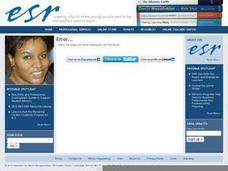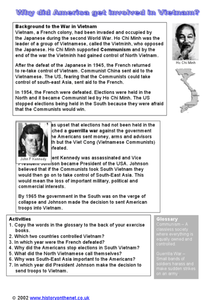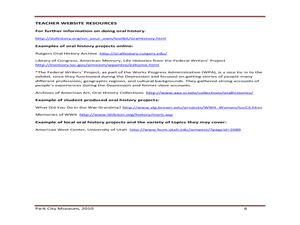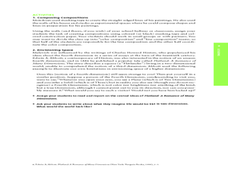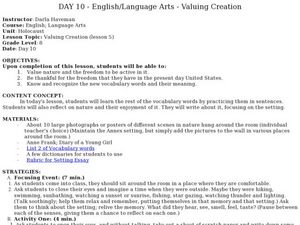Curated OER
Hitler's Lost Sub
Students watch a video clip about German submarines lost during World War II. They work together to create their own submarine out of a plastic bottle. They test the buoyancy of the submarine in different activities.
Curated OER
Lost Peace
Pupils view a television program that chronicles the failure of the League of Nations as a deterrent to further war. They create a timeline of events that led from WWI to WWII and hold a mock town meeting in which they discuss the pros...
Curated OER
Contemporary Afghanistan
Learners research the situational dynamics that have resulted in a civil war.
In small groups, they research the geography and culture of Afghanistan.
Groups analyze the political and cultural impact on people living in Afghanistan....
Curated OER
President John Kennedy
For this President John Kennedy worksheet, learners read a 2 page article and then circle 8 multiple choice answers to 8 questions or facts referring back to the article on President John Kennedy.
Curated OER
Korean Lesson Plan
Seventh graders are introduced to the history of Korea. Using maps, they identify the reasons why Korea is important geographically. They also research the reasons for the Korean War and how actions of the United States and Korea led...
Curated OER
The Crusades
Students investigate the series of religious wars known as the Crusades. In this Crusades lesson, students research Christian and Muslim beliefs and create posters that compare the two. Students discuss the causes of the wars as well as...
Curated OER
Chapters 30 (sections 1 & 5) – The Cold War
In this U.S. history worksheet, students read assigned textbook pages on different topics associated with the Cold War and respond to 50 short answer questions.
Curated OER
Woodrow Wilson: Prophet of Peace
Students read and discuss various speeches by Woodrow Wilson, and write and present a brief radio address that will persuade the nation to return to world peace. Students analyze current events and discuss whether the world has upheld...
Curated OER
Why Did America Get Involved in Vietnam?
In this Vietnam study guide worksheet, learners investigate what led the United States into involvement in the Vietnam War. Students respond to 7 short answer questions based on the worksheet as well as textbook reading.
Curated OER
American History Operation Iraqi Freedom
Learners consider the responsibilities of American troops. In this Operation Iraqi Freedom lesson, students watch video segments regarding the work of the Arkansas National Guard. Learners research media sources to determine the balance...
Curated OER
Current Spanish History 1900-present
Tenth graders study the Spanish Civil War. In this World History lesson, 10th graders analyze famous paintings. Students compare and contrast the government of the United States with that of Spain.
Curated OER
Ancient Greece
Pupils discover the world of ancient Greece. In this ancient Greece lesson, students compare and contrast the culture of Athens and Sparta. Pupils also compare the democracy in Athens with the democracy in the United States today.
Curated OER
Religious Crusades
For this religious Crusades worksheet, students respond to 2 questions that require them to write paragraphs about the effects of the Crusades. Students also examine a map of the wars and respond to short answer questions.
Curated OER
Soviet Suspicions and the Search of Security
In this Cold War worksheet, students read a 1-page selection about Soviet security and then respond to 3 short answer questions.
Curated OER
Stop the Bus: Confronting Our Assumptions About Muslims in America
Students explore Virginia Interfaith Center's A More Perfect Union "Misunderstanding" Ad Campaign, view two episodes of PBS America at a Crossroads series, examine historical context of colonialism and geo-political tensions in Middle...
Curated OER
Inference
Making inferences about what you read is an important skill for both elementary, middle, and high school learners. Focusing on events which occurred during World War II, they answer a series of questions related to what we can infer as...
Canadian War Museum
Comparing Primary and Secondary Sources
This simple two-day lesson plan introduces learners to the differences between primary and secondary sources. The lesson plan includes group work that explores the similarities and differences, and the advantages and disadvantages of...
Curated OER
Communism Quiz One
In this communism learning exercise, students complete short answer questions about communism. Students write answers for 15 questions.
Curated OER
A Day of Infamy:Analyzing FDR’s Pearl Harbor Address
In 1941 FDR spoke out on the events at Pearl Harbor. The class will get to analyze word choice, word meaning, author's craft and structure by analyzing an actual draft of this speech. They will look critically at the words used,...
Gilder Lehrman Institute of American History
Harriet Beecher Stowe Sends Uncle Tom’s Cabin to Victoria and Albert, 1852
Harriet Beecher Stowe's plea for abolition is not only laid plain in her acclaimed novel, Uncle Tom's Cabin, but in her written correspondence as well. High schoolers read a letter written by Stowe to Prince Albert and Queen Victoria to...
Curated OER
Oral History: Park City Museum
Bring U.S. history to your language arts class with this lesson. Middle schoolers complete an interview for an oral history project, and discuss the importance of oral histories - and how they embellish written accounts. They write...
Curated OER
Hiroshima: The Cloze Procedure
What is a cloze passage? The first page of this resource details this procedure and its benefits. To determine if Hiroshima is an appropriate reading-level text for your class, have them read the first passage provided, and then give...
Curated OER
New Visions of the World
Students explore the art of Kazimir Malevich and Piet Mondrian as an analysis of abstract painting. In this abstract painting lesson, students explore the painting style of the two artists. Students analyze the use of shape, line,...
Curated OER
The Holocaust: Valuing Creation
Students write a descriptive essay. In this Holocaust lesson plan, students discuss what it must have been like for Anne Frank to stay inside for two years. Students try to appeal to all five senses in their descriptions.




